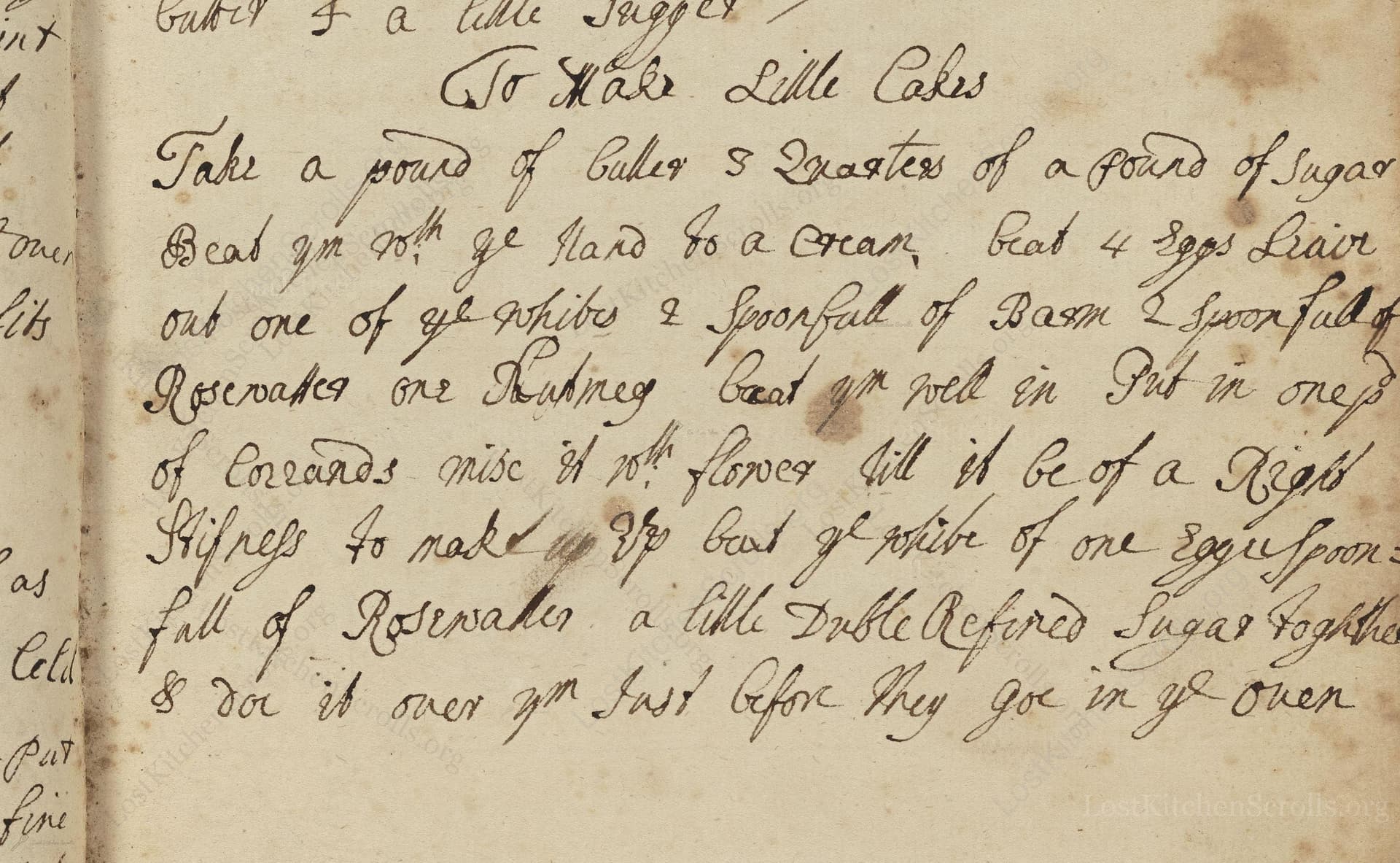To Make Little Cakes
From the treasured pages of Receipt book of Jane Staveley
Written by Jane Staveley

To Make Little Cakes
"Take a pound of Butter 3 Quarters of a pound of Sugar Beat ym wth ye Hand to a Cream, beat 4 eggs Leave out one of ye whites 2 Spoonfull of Barm 2 Spoonfull of Rosewater one Nutmeg beat ym well in Put in one pd of Currants mix it wth flower till it be of a Right stifness to make up beat ye white of one egg wth Spoon-full of Rosewater a litle Double Refined Sugar togather & doe it over ym Just before they goe in ye oven"
Note on the Original Text
The recipe uses period spelling ('ye' for 'the', 'ym' for 'them', 'wth' for 'with') and omits precise timings and temperatures, leaving actions like mixing and baking to the cook’s judgement. Details like 'beat to a cream' and 'right stiffness' rely on experience and feel. Ingredients like 'barm' (brewer’s yeast) are now uncommon, so modern yeast is substituted. The 'double refined sugar' referred then to the purest white sugar available. The direct, imperative tone—'Mix it'...'Doe it over ym'—is typical of manuscript recipes, offering guidance rather than explicit instruction.

Title
Receipt book of Jane Staveley (1693)
You can also click the book image above to peruse the original tome
Writer
Jane Staveley
Era
1693
Publisher
Unknown
Background
Step into the flavorful annals of the 17th century with Jane Staveley’s delightful culinary collection. Brimming with time-honored recipes and refined instructions, this book offers a sumptuous glimpse into the kitchens of yesteryear—where classic techniques met noble tastes and every dish was a celebration of ingenuity.
Kindly made available by
Folger Shakespeare Library
This recipe comes from a late 17th-century English manuscript attributed to Jane Staveley, likely written between 1693 and 1694. During this period, recipes were shared among families and friends, often scribbled in personal household books. The use of barm (yeast skimmed from brewing beer) and rosewater speaks to the culinary traditions of Restoration England, blending robust, homegrown flavors with the exotic and the floral—a popular taste among the well-to-do. These 'little cakes' would have been a treat for festive occasions or afternoon sociability, enjoyed with tea (then a fashionable novelty) or ale.

Cooks of the era would have used large wooden or earthenware bowls for mixing, and their hands or a large spoon for creaming butter and sugar. Eggs were beaten with a simple whisk, often just a bunch of twigs or a fork. Baking was likely done in a brick or stone hearth oven, with cakes placed on shallow pans or sheets, and a peel used for maneuvering them in and out. A fine sieve or cloth was sometimes used to dust sugar, and simple brushes, perhaps of feather or clean fingers, for glazing.
Prep Time
25 mins
Cook Time
20 mins
Servings
16
We've done our best to adapt this historical recipe for modern kitchens, but some details may still need refinement. We warmly welcome feedback from fellow cooks and culinary historians — your insights support the entire community!
Ingredients
- 1 lb unsalted butter
- 12 oz caster sugar
- 3 eggs plus 1 egg yolk (reserve 1 egg white)
- 2 tablespoons (1 fl oz) fresh baker’s yeast (or 0.5 oz fast-action dried yeast)
- 2 tablespoons (1 fl oz) rosewater
- 1 teaspoon grated fresh nutmeg
- 1 lb currants
- Plain wheat flour (about 1 lb 2 oz–1 lb 5 oz, enough to form a stiff dough)
- 1 egg white (for glaze)
- 1 tablespoon (0.5 fl oz) rosewater (for glaze)
- 2 teaspoons icing sugar (for glaze)
Instructions
- Start by beating 1 lb of unsalted butter with 12 oz of caster sugar until the mixture is light and creamy.
- Add in three whole eggs and one egg yolk (reserve one egg white), beating until well incorporated.
- Stir in two tablespoons (about 1 fl oz) of fresh baker's yeast (or substitute with 0.5 oz fast-action dried yeast), two tablespoons (1 fl oz) of rosewater, and a generous grating of fresh nutmeg (about 1 teaspoon).
- Mix in 1 lb of currants.
- Gradually add plain wheat flour, stirring until you have a stiff yet pliable dough suitable for shaping into small cakes.
- Whisk the reserved egg white with a tablespoon of rosewater and a little icing sugar until slightly foamy, and brush this mixture over the cakes before baking.
- Bake in a preheated oven at 350°F (180°C) until golden and cooked through, about 15-20 minutes.
Estimated Calories
350 per serving
Cooking Estimates
It usually takes about 25 minutes to prepare the dough and ingredients, and another 15-20 minutes to bake the cakes. Each cake has about 350 calories, and the recipe makes 16 cakes.
As noted above, we have made our best effort to translate and adapt this historical recipe for modern kitchens, taking into account ingredients nowadays, cooking techniques, measurements, and so on. However, historical recipes often contain assumptions that require interpretation.
We'd love for anyone to help improve these adaptations. Community contributions are highly welcome. If you have suggestions, corrections, or cooking tips based on your experience with this recipe, please share them below.
Join the Discussion
Rate This Recipe

Den Bockfisch In Einer Fleisch Suppen Zu Kochen
This recipe hails from a German manuscript cookbook compiled in 1696, a time whe...

Die Grieß Nudlen Zumachen
This recipe comes from a rather mysterious manuscript cookbook, penned anonymous...

Ein Boudain
This recipe comes from an anonymous German-language manuscript cookbook from 169...

Ein Gesaltzen Citroni
This recipe, dating from 1696, comes from an extensive anonymous German cookbook...
Browse our complete collection of time-honored recipes



